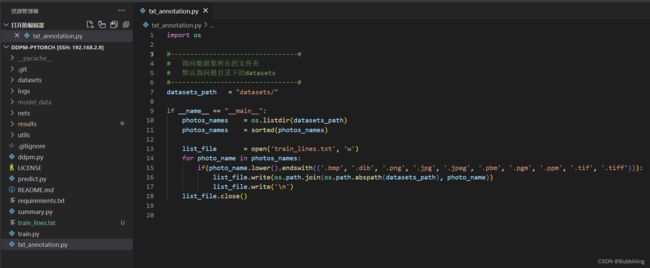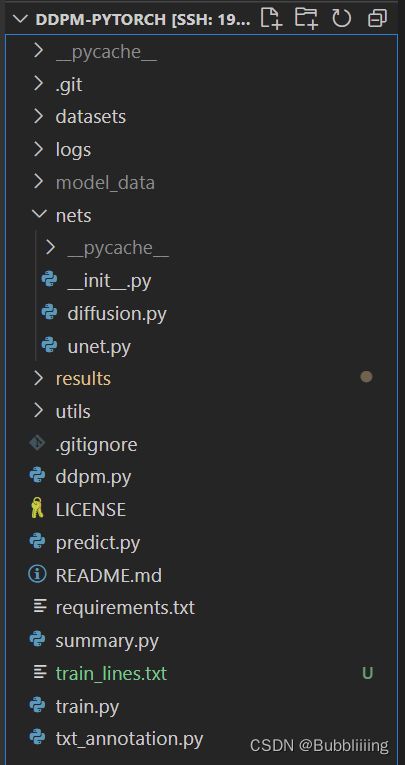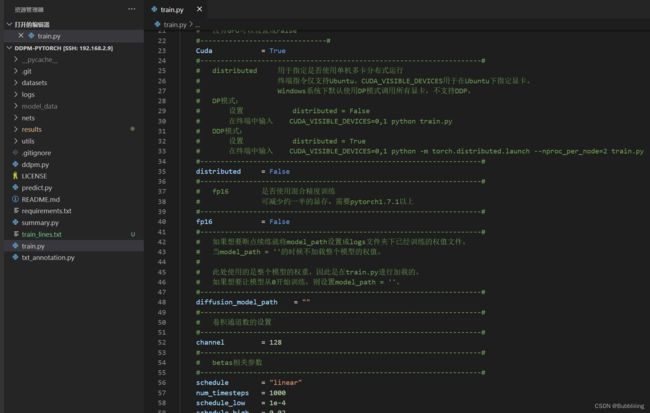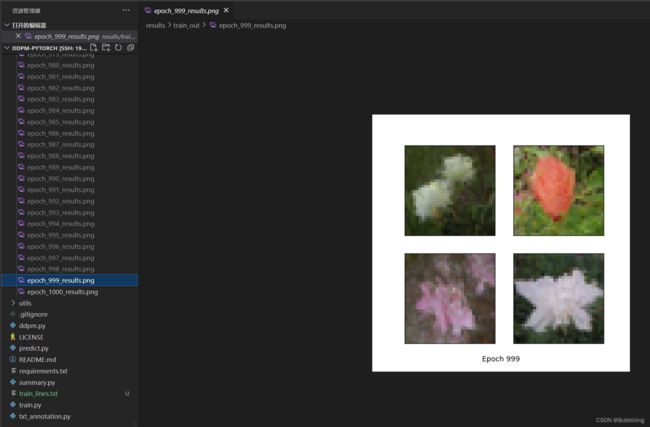Diffusion扩散模型学习1——Pytorch搭建DDPM实现图片生成
Diffusion扩散模型学习1——Pytorch搭建DDPM利用深度卷积神经网络实现图片生成
- 学习前言
- 源码下载地址
- 网络构建
-
- 一、什么是Diffusion
-
- 1、加噪过程
- 2、去噪过程
- 二、DDPM网络的构建(Unet网络的构建)
- 三、Diffusion的训练思路
- 利用DDPM生成图片
-
- 一、数据集的准备
- 二、数据集的处理
- 三、模型训练
学习前言
我又死了我又死了我又死了!
![]()
源码下载地址
https://github.com/bubbliiiing/ddpm-pytorch
喜欢的可以点个star噢。
网络构建
一、什么是Diffusion

如上图所示。DDPM模型主要分为两个过程:
1、Forward加噪过程(从右往左),数据集的真实图片中逐步加入高斯噪声,最终变成一个杂乱无章的高斯噪声,这个过程一般发生在训练的时候。加噪过程满足一定的数学规律。
2、Reverse去噪过程(从左往右),指对加了噪声的图片逐步去噪,从而还原出真实图片,这个过程一般发生在预测生成的时候。尽管在这里说的是加了噪声的图片,但实际去预测生成的时候,是随机生成一个高斯噪声来去噪。去噪的时候不断根据 X t X_t Xt的图片生成 X t − 1 X_{t-1} Xt−1的噪声,从而实现图片的还原。
1、加噪过程

Forward加噪过程主要符合如下的公式:
x t = α t x t − 1 + 1 − α t z 1 x_t=\sqrt{\alpha_t} x_{t-1}+\sqrt{1-\alpha_t} z_{1} xt=αtxt−1+1−αtz1
其中 α t \sqrt{\alpha_t} αt是预先设定好的超参数,被称为Noise schedule,通常是小于1的值,在论文中 α t \alpha_t αt的值从0.9999到0.998。 ϵ t − 1 ∼ N ( 0 , 1 ) \epsilon_{t-1} \sim N(0, 1) ϵt−1∼N(0,1)是高斯噪声。由公式(1)迭代推导。
x t = a t ( a t − 1 x t − 2 + 1 − α t − 1 z 2 ) + 1 − α t z 1 = a t a t − 1 x t − 2 + ( a t ( 1 − α t − 1 ) z 2 + 1 − α t z 1 ) x_t=\sqrt{a_t}\left(\sqrt{a_{t-1}} x_{t-2}+\sqrt{1-\alpha_{t-1}} z_2\right)+\sqrt{1-\alpha_t} z_1=\sqrt{a_t a_{t-1}} x_{t-2}+\left(\sqrt{a_t\left(1-\alpha_{t-1}\right)} z_2+\sqrt{1-\alpha_t} z_1\right) xt=at(at−1xt−2+1−αt−1z2)+1−αtz1=atat−1xt−2+(at(1−αt−1)z2+1−αtz1)
其中每次加入的噪声都服从高斯分布 z 1 , z 2 , … ∼ N ( 0 , 1 ) z_1, z_2, \ldots \sim \mathcal{N}(0, 1) z1,z2,…∼N(0,1),两个高斯分布的相加高斯分布满足公式: N ( 0 , σ 1 2 ) + N ( 0 , σ 2 2 ) ∼ N ( 0 , ( σ 1 2 + σ 2 2 ) ) \mathcal{N}\left(0, \sigma_1^2 \right)+\mathcal{N}\left(0, \sigma_2^2 \right) \sim \mathcal{N}\left(0,\left(\sigma_1^2+\sigma_2^2\right) \right) N(0,σ12)+N(0,σ22)∼N(0,(σ12+σ22)),因此,得到 x t x_t xt的公式为:
x t = a t a t − 1 x t − 2 + 1 − α t α t − 1 z 2 x_t = \sqrt{a_t a_{t-1}} x_{t-2}+\sqrt{1-\alpha_t \alpha_{t-1}} z_2 xt=atat−1xt−2+1−αtαt−1z2
因此不断往里面套,就能发现规律了,其实就是累乘
可以直接得出 x 0 x_0 x0到 x t x_t xt的公式:
x t = α t ‾ x 0 + 1 − α t ‾ z t x_t=\sqrt{\overline{\alpha_t}} x_0+\sqrt{1-\overline{\alpha_t}} z_t xt=αtx0+1−αtzt
其中 α t ‾ = ∏ i t α i \overline{\alpha_t}=\prod_i^t \alpha_i αt=∏itαi,这是随Noise schedule设定好的超参数, z t − 1 ∼ N ( 0 , 1 ) z_{t-1} \sim N(0, 1) zt−1∼N(0,1)也是一个高斯噪声。通过上述两个公式,我们可以不断的将图片进行破坏加噪。
2、去噪过程

反向过程就是通过估测噪声,多次迭代逐渐将被破坏的 x t x_t xt恢复成 x 0 x_0 x0,在恢复时刻,我们已经知道的是 x t x_t xt,这是图片在 t t t时刻的噪声图。一下子从 x t x_t xt恢复成 x 0 x_0 x0是不可能的,我们只能一步一步的往前推,首先从 x t x_t xt恢复成 x t − 1 x_{t-1} xt−1。根据贝叶斯公式,已知 x t x_t xt反推 x t − 1 x_{t-1} xt−1:
q ( x t − 1 ∣ x t , x 0 ) = q ( x t ∣ x t − 1 , x 0 ) q ( x t − 1 ∣ x 0 ) q ( x t ∣ x 0 ) q\left(x_{t-1} \mid x_t, x_0\right)=q\left(x_t \mid x_{t-1}, x_0\right) \frac{q\left(x_{t-1} \mid x_0\right)}{q\left(x_t \mid x_0\right)} q(xt−1∣xt,x0)=q(xt∣xt−1,x0)q(xt∣x0)q(xt−1∣x0)
右边的三个东西都可以从x_0开始推得到:
q ( x t − 1 ∣ x 0 ) = a ˉ t − 1 x 0 + 1 − a ˉ t − 1 z ∼ N ( a ˉ t − 1 x 0 , 1 − a ˉ t − 1 ) q\left(x_{t-1} \mid x_0\right)=\sqrt{\bar{a}_{t-1}} x_0+\sqrt{1-\bar{a}_{t-1}} z \sim \mathcal{N}\left(\sqrt{\bar{a}_{t-1}} x_0, 1-\bar{a}_{t-1}\right) q(xt−1∣x0)=aˉt−1x0+1−aˉt−1z∼N(aˉt−1x0,1−aˉt−1)
q ( x t ∣ x 0 ) = a ˉ t x 0 + 1 − α ˉ t z ∼ N ( a ˉ t x 0 , 1 − α ˉ t ) q\left(x_t \mid x_0\right) = \sqrt{\bar{a}_t} x_0+\sqrt{1-\bar{\alpha}_t} z \sim \mathcal{N}\left(\sqrt{\bar{a}_t} x_0 , 1-\bar{\alpha}_t\right) q(xt∣x0)=aˉtx0+1−αˉtz∼N(aˉtx0,1−αˉt)
q ( x t ∣ x t − 1 , x 0 ) = a t x t − 1 + 1 − α t z ∼ N ( a t x t − 1 , 1 − α t ) q\left(x_t \mid x_{t-1}, x_0\right)=\sqrt{a_t} x_{t-1}+\sqrt{1-\alpha_t} z \sim \mathcal{N}\left(\sqrt{a_t} x_{t-1}, 1-\alpha_t\right) \\ q(xt∣xt−1,x0)=atxt−1+1−αtz∼N(atxt−1,1−αt)
因此,由于右边三个东西均满足正态分布, q ( x t − 1 ∣ x t , x 0 ) q\left(x_{t-1} \mid x_t, x_0\right) q(xt−1∣xt,x0)满足分布如下:
∝ exp ( − 1 2 ( ( x t − α t x t − 1 ) 2 β t + ( x t − 1 − α ˉ t − 1 x 0 ) 2 1 − α ˉ t − 1 − ( x t − α ˉ t x 0 ) 2 1 − α ˉ t ) ) \propto \exp \left(-\frac{1}{2}\left(\frac{\left(x_t-\sqrt{\alpha_t} x_{t-1}\right)^2}{\beta_t}+\frac{\left(x_{t-1}-\sqrt{\bar{\alpha}_{t-1}} x_0\right)^2}{1-\bar{\alpha}_{t-1}}-\frac{\left(x_t-\sqrt{\bar{\alpha}_t} x_0\right)^2}{1-\bar{\alpha}_t}\right)\right) ∝exp(−21(βt(xt−αtxt−1)2+1−αˉt−1(xt−1−αˉt−1x0)2−1−αˉt(xt−αˉtx0)2))
把标准正态分布展开后,乘法就相当于加,除法就相当于减,把他们汇总
接下来继续化简,咱们现在要求的是上一时刻的分布
∝ exp ( − 1 2 ( ( x t − α t x t − 1 ) 2 β t + ( x t − 1 − α ˉ t − 1 x 0 ) 2 1 − α ˉ t − 1 − ( x t − α ˉ t x 0 ) 2 1 − α ˉ t ) ) = exp ( − 1 2 ( x t 2 − 2 α t x t x t − 1 + α t x t − 1 2 β t + x t − 1 2 − 2 α ˉ t − 1 x 0 x t − 1 + α ˉ t − 1 x 0 2 1 − α ˉ t − 1 − ( x t − α ˉ t x 0 ) 2 1 − α ˉ t ) ) = exp ( − 1 2 ( ( α t β t + 1 1 − α ˉ t − 1 ) x t − 1 2 − ( 2 α t β t x t + 2 α ˉ t − 1 1 − α ˉ t − 1 x 0 ) x t − 1 + C ( x t , x 0 ) ) ) \begin{aligned} & \propto \exp \left(-\frac{1}{2}\left(\frac{\left(x_t-\sqrt{\alpha_t} x_{t-1}\right)^2}{\beta_t}+\frac{\left(x_{t-1}-\sqrt{\bar{\alpha}_{t-1}} x_0\right)^2}{1-\bar{\alpha}_{t-1}}-\frac{\left(x_t-\sqrt{\bar{\alpha}_t} x_0\right)^2}{1-\bar{\alpha}_t}\right)\right) \\ & =\exp \left(-\frac{1}{2}\left(\frac{x_t^2-2 \sqrt{\alpha_t} x_t x_{t-1}+\alpha_t x_{t-1}^2}{\beta_t}+\frac{x_{t-1}^2-2 \sqrt{\bar{\alpha}_{t-1}} x_0 x_{t-1}+\bar{\alpha}_{t-1} x_0^2}{1-\bar{\alpha}_{t-1}}-\frac{\left(x_t-\sqrt{\bar{\alpha}_t} x_0\right)^2}{1-\bar{\alpha}_t}\right)\right) \\ & =\exp \left(-\frac{1}{2}\left(\left(\frac{\alpha_t}{\beta_t}+\frac{1}{1-\bar{\alpha}_{t-1}}\right) x_{t-1}^2-\left(\frac{2 \sqrt{\alpha_t}}{\beta_t} x_t+\frac{2 \sqrt{\bar{\alpha}_{t-1}}}{1-\bar{\alpha}_{t-1}} x_0\right) x_{t-1}+C\left(x_t, x_0\right)\right)\right) \end{aligned} ∝exp(−21(βt(xt−αtxt−1)2+1−αˉt−1(xt−1−αˉt−1x0)2−1−αˉt(xt−αˉtx0)2))=exp(−21(βtxt2−2αtxtxt−1+αtxt−12+1−αˉt−1xt−12−2αˉt−1x0xt−1+αˉt−1x02−1−αˉt(xt−αˉtx0)2))=exp(−21((βtαt+1−αˉt−11)xt−12−(βt2αtxt+1−αˉt−12αˉt−1x0)xt−1+C(xt,x0)))
正态分布满足公式, exp ( − ( x − μ ) 2 2 σ 2 ) = exp ( − 1 2 ( 1 σ 2 x 2 − 2 μ σ 2 x + μ 2 σ 2 ) ) \exp \left(-\frac{(x-\mu)^2}{2 \sigma^2}\right)=\exp \left(-\frac{1}{2}\left(\frac{1}{\sigma^2} x^2-\frac{2 \mu}{\sigma^2} x+\frac{\mu^2}{\sigma^2}\right)\right) exp(−2σ2(x−μ)2)=exp(−21(σ21x2−σ22μx+σ2μ2)),其中 σ \sigma σ就是方差, μ \mu μ就是均值,配方后我们就可以获得均值和方差。
此时的均值为: μ ~ t ( x t , x 0 ) = α t ( 1 − α ˉ t − 1 ) 1 − α ˉ t x t + α ˉ t − 1 β t 1 − α ˉ t x 0 \tilde{\mu}_t\left(x_t, x_0\right)=\frac{\sqrt{\alpha_t}\left(1-\bar{\alpha}_{t-1}\right)}{1-\bar{\alpha}_t} x_t+\frac{\sqrt{\bar{\alpha}_{t-1}} \beta_t}{1-\bar{\alpha}_t} x_0 μ~t(xt,x0)=1−αˉtαt(1−αˉt−1)xt+1−αˉtαˉt−1βtx0。根据之前的公式, x t = α t ‾ x 0 + 1 − α t ‾ z t x_t=\sqrt{\overline{\alpha_t}} x_0+\sqrt{1-\overline{\alpha_t}} z_t xt=αtx0+1−αtzt,我们可以使用 x t x_t xt反向估计 x 0 x_0 x0得到 x 0 x_0 x0满足分布 x 0 = 1 α ˉ t ( x t − 1 − α ˉ t z t ) x_0=\frac{1}{\sqrt{\bar{\alpha}_t}}\left(\mathrm{x}_t-\sqrt{1-\bar{\alpha}_t} z_t\right) x0=αˉt1(xt−1−αˉtzt)。最终得到均值为 μ ~ t = 1 a t ( x t − β t 1 − a ˉ t z t ) \tilde{\mu}_t=\frac{1}{\sqrt{a_t}}\left(x_t-\frac{\beta_t}{\sqrt{1-\bar{a}_t}} z_t\right) μ~t=at1(xt−1−aˉtβtzt) , z t z_t zt代表t时刻的噪音是什么。由 z t z_t zt无法直接获得,网络便通过当前时刻的 x t x_t xt经过神经网络计算 z t z_t zt。 ϵ θ ( x t , t ) \epsilon_\theta\left(x_t, t\right) ϵθ(xt,t)也就是上面提到的 z t z_t zt。 ϵ θ \epsilon_\theta ϵθ代表神经网络。
x t − 1 = 1 α t ( x t − 1 − α t 1 − α ˉ t ϵ θ ( x t , t ) ) + σ t z x_{t-1}=\frac{1}{\sqrt{\alpha_t}}\left(x_t-\frac{1-\alpha_t}{\sqrt{1-\bar{\alpha}_t}} \epsilon_\theta\left(x_t, t\right)\right)+\sigma_t z xt−1=αt1(xt−1−αˉt1−αtϵθ(xt,t))+σtz
由于加噪过程中的真实噪声 ϵ \epsilon ϵ在复原过程中是无法获得的,因此DDPM的关键就是训练一个由 x t x_t xt和 t t t估测橾声的模型 ϵ θ ( x t , t ) \epsilon_\theta\left(x_t, t\right) ϵθ(xt,t),其中 θ \theta θ就是模型的训练参数, σ t \sigma_t σt 也是一个高斯噪声 σ t ∼ N ( 0 , 1 ) \sigma_t \sim N(0,1) σt∼N(0,1),用于表示估测与实际的差距。在DDPM中,使用U-Net作为估测噪声的模型。
本质上,我们就是训练这个Unet模型,该模型输入为 x t x_t xt和 t t t,输出为 x t x_t xt时刻的高斯噪声。即利用 x t x_t xt和 t t t预测这一时刻的高斯噪声。这样就可以一步一步的再从噪声回到真实图像。
二、DDPM网络的构建(Unet网络的构建)
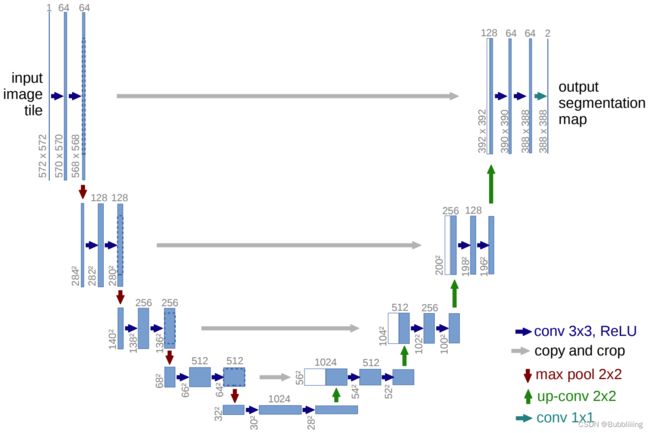
上图是典型的Unet模型结构,仅仅作为示意图,里面具体的数字同学们无需在意,和本文的学习无关。在本文中,Unet的输入和输出shape相同,通道均为3(一般为RGB三通道),宽高相同。
本质上,DDPM最重要的工作就是训练Unet模型,该模型输入为 x t x_t xt和 t t t,输出为 x t − 1 x_{t-1} xt−1时刻的高斯噪声。即利用 x t x_t xt和 t t t预测上一时刻的高斯噪声。这样就可以一步一步的再从噪声回到真实图像。
假设我们需要生成一个[64, 64, 3]的图像,在 t t t时刻,我们有一个 x t x_t xt噪声图,该噪声图的的shape也为[64, 64, 3],我们将它和 t t t一起输入到Unet中。Unet的输出为 x t − 1 x_{t-1} xt−1时刻的[64, 64, 3]的噪声。
实现代码如下,代码中的特征提取模块为残差结构,方便优化:
import math
import torch
import torch.nn as nn
import torch.nn.functional as F
def get_norm(norm, num_channels, num_groups):
if norm == "in":
return nn.InstanceNorm2d(num_channels, affine=True)
elif norm == "bn":
return nn.BatchNorm2d(num_channels)
elif norm == "gn":
return nn.GroupNorm(num_groups, num_channels)
elif norm is None:
return nn.Identity()
else:
raise ValueError("unknown normalization type")
#------------------------------------------#
# 计算时间步长的位置嵌入。
# 一半为sin,一半为cos。
#------------------------------------------#
class PositionalEmbedding(nn.Module):
def __init__(self, dim, scale=1.0):
super().__init__()
assert dim % 2 == 0
self.dim = dim
self.scale = scale
def forward(self, x):
device = x.device
half_dim = self.dim // 2
emb = math.log(10000) / half_dim
emb = torch.exp(torch.arange(half_dim, device=device) * -emb)
# x * self.scale和emb外积
emb = torch.outer(x * self.scale, emb)
emb = torch.cat((emb.sin(), emb.cos()), dim=-1)
return emb
#------------------------------------------#
# 下采样层,一个步长为2x2的卷积
#------------------------------------------#
class Downsample(nn.Module):
def __init__(self, in_channels):
super().__init__()
self.downsample = nn.Conv2d(in_channels, in_channels, 3, stride=2, padding=1)
def forward(self, x, time_emb, y):
if x.shape[2] % 2 == 1:
raise ValueError("downsampling tensor height should be even")
if x.shape[3] % 2 == 1:
raise ValueError("downsampling tensor width should be even")
return self.downsample(x)
#------------------------------------------#
# 上采样层,Upsample+卷积
#------------------------------------------#
class Upsample(nn.Module):
def __init__(self, in_channels):
super().__init__()
self.upsample = nn.Sequential(
nn.Upsample(scale_factor=2, mode="nearest"),
nn.Conv2d(in_channels, in_channels, 3, padding=1),
)
def forward(self, x, time_emb, y):
return self.upsample(x)
#------------------------------------------#
# 使用Self-Attention注意力机制
# 做一个全局的Self-Attention
#------------------------------------------#
class AttentionBlock(nn.Module):
def __init__(self, in_channels, norm="gn", num_groups=32):
super().__init__()
self.in_channels = in_channels
self.norm = get_norm(norm, in_channels, num_groups)
self.to_qkv = nn.Conv2d(in_channels, in_channels * 3, 1)
self.to_out = nn.Conv2d(in_channels, in_channels, 1)
def forward(self, x):
b, c, h, w = x.shape
q, k, v = torch.split(self.to_qkv(self.norm(x)), self.in_channels, dim=1)
q = q.permute(0, 2, 3, 1).view(b, h * w, c)
k = k.view(b, c, h * w)
v = v.permute(0, 2, 3, 1).view(b, h * w, c)
dot_products = torch.bmm(q, k) * (c ** (-0.5))
assert dot_products.shape == (b, h * w, h * w)
attention = torch.softmax(dot_products, dim=-1)
out = torch.bmm(attention, v)
assert out.shape == (b, h * w, c)
out = out.view(b, h, w, c).permute(0, 3, 1, 2)
return self.to_out(out) + x
#------------------------------------------#
# 用于特征提取的残差结构
#------------------------------------------#
class ResidualBlock(nn.Module):
def __init__(
self, in_channels, out_channels, dropout, time_emb_dim=None, num_classes=None, activation=F.relu,
norm="gn", num_groups=32, use_attention=False,
):
super().__init__()
self.activation = activation
self.norm_1 = get_norm(norm, in_channels, num_groups)
self.conv_1 = nn.Conv2d(in_channels, out_channels, 3, padding=1)
self.norm_2 = get_norm(norm, out_channels, num_groups)
self.conv_2 = nn.Sequential(
nn.Dropout(p=dropout),
nn.Conv2d(out_channels, out_channels, 3, padding=1),
)
self.time_bias = nn.Linear(time_emb_dim, out_channels) if time_emb_dim is not None else None
self.class_bias = nn.Embedding(num_classes, out_channels) if num_classes is not None else None
self.residual_connection = nn.Conv2d(in_channels, out_channels, 1) if in_channels != out_channels else nn.Identity()
self.attention = nn.Identity() if not use_attention else AttentionBlock(out_channels, norm, num_groups)
def forward(self, x, time_emb=None, y=None):
out = self.activation(self.norm_1(x))
# 第一个卷积
out = self.conv_1(out)
# 对时间time_emb做一个全连接,施加在通道上
if self.time_bias is not None:
if time_emb is None:
raise ValueError("time conditioning was specified but time_emb is not passed")
out += self.time_bias(self.activation(time_emb))[:, :, None, None]
# 对种类y_emb做一个全连接,施加在通道上
if self.class_bias is not None:
if y is None:
raise ValueError("class conditioning was specified but y is not passed")
out += self.class_bias(y)[:, :, None, None]
out = self.activation(self.norm_2(out))
# 第二个卷积+残差边
out = self.conv_2(out) + self.residual_connection(x)
# 最后做个Attention
out = self.attention(out)
return out
#------------------------------------------#
# Unet模型
#------------------------------------------#
class UNet(nn.Module):
def __init__(
self, img_channels, base_channels=128, channel_mults=(1, 2, 2, 2),
num_res_blocks=2, time_emb_dim=128 * 4, time_emb_scale=1.0, num_classes=None, activation=F.silu,
dropout=0.1, attention_resolutions=(1,), norm="gn", num_groups=32, initial_pad=0,
):
super().__init__()
# 使用到的激活函数,一般为SILU
self.activation = activation
# 是否对输入进行padding
self.initial_pad = initial_pad
# 需要去区分的类别数
self.num_classes = num_classes
# 对时间轴输入的全连接层
self.time_mlp = nn.Sequential(
PositionalEmbedding(base_channels, time_emb_scale),
nn.Linear(base_channels, time_emb_dim),
nn.SiLU(),
nn.Linear(time_emb_dim, time_emb_dim),
) if time_emb_dim is not None else None
# 对输入图片的第一个卷积
self.init_conv = nn.Conv2d(img_channels, base_channels, 3, padding=1)
# self.downs用于存储下采样用到的层,首先利用ResidualBlock提取特征
# 然后利用Downsample降低特征图的高宽
self.downs = nn.ModuleList()
self.ups = nn.ModuleList()
# channels指的是每一个模块处理后的通道数
# now_channels是一个中间变量,代表中间的通道数
channels = [base_channels]
now_channels = base_channels
for i, mult in enumerate(channel_mults):
out_channels = base_channels * mult
for _ in range(num_res_blocks):
self.downs.append(
ResidualBlock(
now_channels, out_channels, dropout,
time_emb_dim=time_emb_dim, num_classes=num_classes, activation=activation,
norm=norm, num_groups=num_groups, use_attention=i in attention_resolutions,
)
)
now_channels = out_channels
channels.append(now_channels)
if i != len(channel_mults) - 1:
self.downs.append(Downsample(now_channels))
channels.append(now_channels)
# 可以看作是特征整合,中间的一个特征提取模块
self.mid = nn.ModuleList(
[
ResidualBlock(
now_channels, now_channels, dropout,
time_emb_dim=time_emb_dim, num_classes=num_classes, activation=activation,
norm=norm, num_groups=num_groups, use_attention=True,
),
ResidualBlock(
now_channels, now_channels, dropout,
time_emb_dim=time_emb_dim, num_classes=num_classes, activation=activation,
norm=norm, num_groups=num_groups, use_attention=False,
),
]
)
# 进行上采样,进行特征融合
for i, mult in reversed(list(enumerate(channel_mults))):
out_channels = base_channels * mult
for _ in range(num_res_blocks + 1):
self.ups.append(ResidualBlock(
channels.pop() + now_channels, out_channels, dropout,
time_emb_dim=time_emb_dim, num_classes=num_classes, activation=activation,
norm=norm, num_groups=num_groups, use_attention=i in attention_resolutions,
))
now_channels = out_channels
if i != 0:
self.ups.append(Upsample(now_channels))
assert len(channels) == 0
self.out_norm = get_norm(norm, base_channels, num_groups)
self.out_conv = nn.Conv2d(base_channels, img_channels, 3, padding=1)
def forward(self, x, time=None, y=None):
# 是否对输入进行padding
ip = self.initial_pad
if ip != 0:
x = F.pad(x, (ip,) * 4)
# 对时间轴输入的全连接层
if self.time_mlp is not None:
if time is None:
raise ValueError("time conditioning was specified but tim is not passed")
time_emb = self.time_mlp(time)
else:
time_emb = None
if self.num_classes is not None and y is None:
raise ValueError("class conditioning was specified but y is not passed")
# 对输入图片的第一个卷积
x = self.init_conv(x)
# skips用于存放下采样的中间层
skips = [x]
for layer in self.downs:
x = layer(x, time_emb, y)
skips.append(x)
# 特征整合与提取
for layer in self.mid:
x = layer(x, time_emb, y)
# 上采样并进行特征融合
for layer in self.ups:
if isinstance(layer, ResidualBlock):
x = torch.cat([x, skips.pop()], dim=1)
x = layer(x, time_emb, y)
# 上采样并进行特征融合
x = self.activation(self.out_norm(x))
x = self.out_conv(x)
if self.initial_pad != 0:
return x[:, :, ip:-ip, ip:-ip]
else:
return x
三、Diffusion的训练思路
Diffusion的训练思路比较简单,首先随机给每个batch里每张图片都生成一个t,代表我选择这个batch里面第t个时刻的噪声进行拟合。代码如下:
t = torch.randint(0, self.num_timesteps, (b,), device=device)
生成batch_size个噪声,计算施加这个噪声后模型在t个时刻的噪声图片是怎么样的,如下所示:
def perturb_x(self, x, t, noise):
return (
extract(self.sqrt_alphas_cumprod, t, x.shape) * x +
extract(self.sqrt_one_minus_alphas_cumprod, t, x.shape) * noise
)
def get_losses(self, x, t, y):
# x, noise [batch_size, 3, 64, 64]
noise = torch.randn_like(x)
perturbed_x = self.perturb_x(x, t, noise)
之后利用这个噪声图片、t和网络模型计算预测噪声,利用预测噪声和实际噪声进行拟合。
def get_losses(self, x, t, y):
# x, noise [batch_size, 3, 64, 64]
noise = torch.randn_like(x)
perturbed_x = self.perturb_x(x, t, noise)
estimated_noise = self.model(perturbed_x, t, y)
if self.loss_type == "l1":
loss = F.l1_loss(estimated_noise, noise)
elif self.loss_type == "l2":
loss = F.mse_loss(estimated_noise, noise)
return loss
利用DDPM生成图片
一、数据集的准备
在训练前需要准备好数据集,数据集保存在datasets文件夹里面。
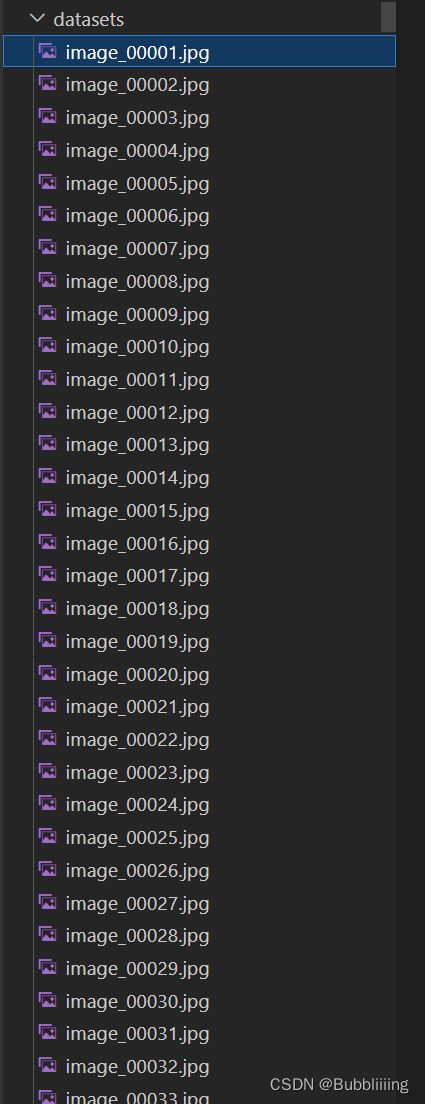
二、数据集的处理
打开txt_annotation.py,默认指向根目录下的datasets。运行txt_annotation.py。
此时生成根目录下面的train_lines.txt。
